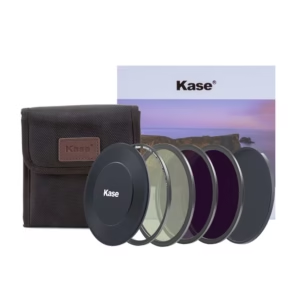When it comes to capturing the perfect landscape photo, using the right filters can make a world of difference. Filters help enhance colors, control light, and balance exposure, allowing you to capture the scene as you envision it—or even improve on it. Whether you’re a beginner or a seasoned pro, here are some of the most useful photo filters for landscape photography and how to use them to elevate your shots.
This post may contain affiliate links, which means that I may receive a commission if you make a purchase using this links. As an Amazon Associate I earn from qualifying purchases. Nevertheless tis site always displays true and honest review and information and will not try to mislead audience in any way.
1. Polarizing Filter
A polarizing filter is a must-have for landscape photographers. It helps reduce glare and reflections, intensifies colors, and enhances contrast. It’s especially useful when shooting scenes with water, skies, or foliage.
• Reduces Glare: Polarizers minimize reflections on water and wet surfaces, making lakes, rivers, and ocean shots appear clearer.
• Enhances Sky: This filter deepens blue skies, making them pop against clouds or other landscape elements, adding depth to your composition.
• Saturates Colors: Polarizers bring out the natural colors in trees, leaves, and grass, making greens richer and more vibrant.
When to Use: Polarizing filters are perfect for midday shooting when the sun is higher in the sky and reflections or glare might be more prominent.
2. Neutral Density (ND) Filter
A neutral density (ND) filter reduces the amount of light entering your camera without altering the color of the image. It’s invaluable for capturing long exposure shots during bright conditions.
• Smooth Water and Clouds: ND filters allow you to use slower shutter speeds, creating the dreamy, soft effect often seen in water and cloud photography.
• Creative Motion Blur: Use it to blur the motion of rivers, waterfalls, or even passing clouds, creating dynamic and ethereal compositions.
• Shooting in Bright Light: If you’re photographing landscapes on a bright day, an ND filter lets you use a wider aperture and slower shutter speed without overexposing the image.
When to Use: ND filters are ideal for shooting waterfalls, seascapes, and fast-moving clouds during daylight, especially when you want to emphasize motion or create a silky effect.
3. Graduated Neutral Density (GND) Filter
A graduated neutral density (GND) filter is another essential tool for balancing exposure in high-contrast scenes. Unlike a standard ND filter, a GND filter darkens only part of the image, transitioning from clear to darker.
• Balance Bright Skies and Dark Foregrounds: In scenes with a bright sky and darker landscape, a GND filter prevents overexposure of the sky while preserving detail in the land.
• Preserves Sky Detail: It helps bring out details in the sky (like clouds or sunset hues) without underexposing the foreground.
When to Use: Use GND filters for sunrise or sunset photography, or whenever the sky is much brighter than the land below.
4. Reverse Graduated ND Filter
A reverse graduated ND filter is specifically designed for sunrise and sunset photography. It has the darkest part of the filter in the center, with a gradual transition to the top and bottom.
• Tames Intense Horizons: The reverse GND filter is perfect for scenes where the sun is near the horizon. It helps prevent the sun’s harsh brightness from overexposing the image while maintaining detail in the sky and landscape.
When to Use: This filter is most effective for sunrise or sunset shots where the brightest part of the scene is near the horizon, but the sky above and land below still require balanced exposure.
5. UV/Haze Filter
While UV or haze filters were originally designed to block ultraviolet light and reduce atmospheric haze, modern digital sensors don’t require this protection as much as film cameras once did. However, many photographers still use UV filters for one primary reason: lens protection.
• Protects Your Lens: A UV filter acts as a protective layer for your lens against scratches, dirt, dust, and moisture without affecting image quality.
• Reduces Haze: In some cases, UV filters can help reduce the haziness in high-altitude or coastal scenes.
When to Use: While UV filters are optional for image quality, they’re great for protecting your expensive lenses in harsh environments.
6. Color-Enhancing Filter
A color-enhancing filter boosts specific colors in the scene, especially reds, oranges, and greens. It’s useful for bringing out the vibrancy in autumn foliage or sunrises and sunsets.
• Enhances Autumn Landscapes: The filter makes the colors of leaves, flowers, and sunsets more vivid without oversaturation.
• Warmer Tones: Use it to add warmth and depth to landscapes, especially in golden hour conditions.
When to Use: Color-enhancing filters are ideal for fall landscapes, desert scenes, or any situation where the warm tones of the environment play a crucial role in the image.
7. Infrared Filter
An infrared filter blocks visible light and only allows infrared light to reach the camera sensor. This can create surreal, dream-like images where green foliage turns white, and skies turn dark.
• Creates Surreal Effects: Infrared photography transforms ordinary landscapes into unique, otherworldly scenes, with striking contrasts and inverted colors.
• Dramatic Contrast: Foliage glows in white, while skies and water often appear almost black, creating dramatic, high-contrast images.
When to Use: Use an infrared filter when you want to capture a unique and creative vision of a landscape, often during midday when the sun is brightest.
8. Warming and Cooling Filters
Warming and cooling filters adjust the overall color temperature of a scene, helping you achieve the desired mood or correct a color cast in your landscape images.
• Warming Filters: These filters add a subtle orange or yellow tint, making the scene feel warmer and more inviting, ideal for shooting in overcast or blue-tinted environments.
• Cooling Filters: These add a bluish tint to the scene, helping to neutralize overly warm tones, perfect for shots during the golden hour or in desert environments.
When to Use: Warming and cooling filters are useful when you want to correct or enhance the color temperature of your shot without relying on post-processing.
Conclusion
The right photo filter can transform your landscape photography by enhancing colors, controlling light, and allowing you to capture a scene as you envision it. Polarizing filters for glare reduction, ND filters for long exposures, and GND filters for balanced skies and land are among the most essential tools in any landscape photographer’s kit. Whether you’re photographing waterfalls, mountains, or sunsets, using these filters will help you create more dynamic and visually compelling images. Happy shooting!
BUYING GUIDE
| SIZE (mm) | POLARIZER | ND 2-32 + CPL | ND64 |
|---|---|---|---|
| 37 | BUY K&F | ||
| 39 | BUY K&F | ||
| 43 | BUY K&F | ||
| 46 | BUY K&F | ||
| 49 | BUY K&F | BUY K&F | BUY HOYA |
| 52 | BUY K&F | BUY K&F | BUY HOYA |
| 58 | BUY K&F | BUY K&F | |
| 62 | BUY K&F | BUY K&F | BUY HOYA |
| 67 | BUY K&F | BUY K&F | BUY HOYA |
| 72 | BUY K&F | BUY K&F | BUY HOYA |
| 77 | BUY K&F | BUY K&F | BUY HOYA |
| 82 | BUY K&F | BUY K&F | BUY GOBE |
| 95 | BUY K&F | BUY K&F | BUY GOBE |
OPTIMIZED FILTER SYSTEMS

KASE ROUND Professional ND Filter Set
All in one, optimized system, with magnetic mount for ease of use. Properties
| Diameter: | 67-112mm (according to lens) |
|---|---|
| Filter Shape: | Circular |
| Mount: | Magnetisch |
| Neutral Density: | ND8, ND64, ND1000 |
| Product type: | ND Filter, Polarising filter |
| Series: | ROUND Magnetic |
| Stops: | 3 Stops, 6 Stops, 10 Stops |




